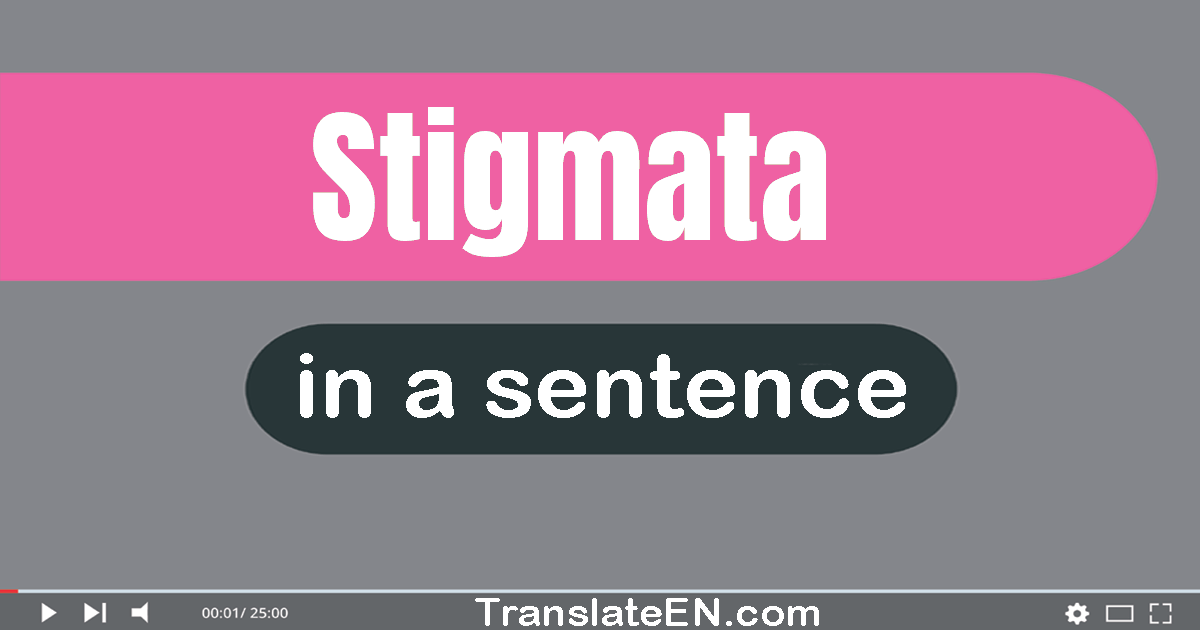Stigmata in a sentence
Synonym: marks.
Meaning: marks corresponding to the wounds of Christ

(1) The stigmata on his face were a rare and unusual occurrence.
(2) The boy claimed to have stigmata after a near-death experience.
(3) The stigmata on his back were a sign of his commitment to his faith.
(4) The stigmata on her hands were a sign of her deep religious devotion.
(5) The man's stigmata were so severe that he had trouble using his hands.
(6) The stigmata on her body were a source of fascination for many people.
(7) The sainted Padre Pio was renowned for his healing powers and stigmata.
(8) The woman's stigmata were so pronounced that she had trouble hiding them.
(9) The stigmata on her feet were a painful reminder of her religious beliefs.
(10) The priest was known for his stigmata and was often sought out for healing.
Stigmata sentence
(11) The stigmata of grief were evident in her tear-stained face and heavy heart.
(12) The stigmata on his hands were a clear indication of his devotion to Christ.
(13) The woman claimed to have stigmata on her forehead, but many were skeptical.
(14) Saint Gemma Galgani is an Italian saint known for her writings and stigmata.
(15) The stigmata of addiction were evident in his trembling hands and hollow eyes.
(16) The stigmata of illness were visible in her weakened body and pale complexion.
(17) The stigmata of poverty were evident in the worn-out clothes and empty cupboards.
(18) The stigmata of poverty were etched in the dilapidated buildings and overcrowded streets.
(19) Saint Francis is believed to have received the stigmata, the wounds of Christ, on his hands and feet.
(20) St. Francis of Assisi is believed to have received the stigmata, the wounds of Christ, on his hands and feet.
Stigmata meaning
Stigmata is a word that holds significant meaning and is often used in religious and medical contexts. It refers to the marks or wounds that resemble those of Jesus Christ's crucifixion, appearing on the hands, feet, and side. In a medical sense, stigmata can also refer to any bodily marks or wounds that are unexplained or have no apparent cause. When using the word "stigmata" in a sentence, it is important to consider the context and ensure that it is used correctly. Here are some tips on how to use this word effectively:
1. Religious Context: - "The devout believer claimed to have experienced stigmata, with wounds appearing on her palms and feet, resembling those of Jesus." - "The painting depicted the crucifixion scene with great detail, including the stigmata on Jesus' hands and side."
2. Medical Context: - "The patient presented with stigmata-like wounds on his body, but doctors were unable to determine the cause." - "The medical team conducted extensive tests to understand the origin of the stigmata observed on the patient's back."
3. Figurative Use: - "The city's crumbling infrastructure was a stigmata of neglect and poor governance." - "Her emotional scars were like stigmata, a constant reminder of the trauma she had endured."
4. Historical or Cultural References: - "The artist's work often explores themes of religion and spirituality, with recurring motifs of stigmata." - "In medieval times, individuals claiming to have stigmata were often revered as holy figures."
5. Proper Pronunciation: - The word "stigmata" is pronounced as stig-muh-tuh, with the emphasis on the first syllable. Remember to use the word "stigmata" in a way that accurately reflects its meaning and fits the context of your sentence. Whether you are discussing religious beliefs, medical phenomena, or metaphorical representations, these tips will help you effectively incorporate this word into your writing.
The word usage examples above have been gathered from various sources to reflect current and historical usage of the word Stigmata. They do not represent the opinions of TranslateEN.com.
